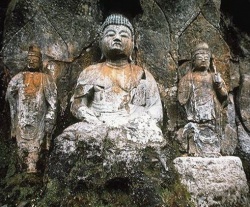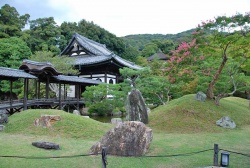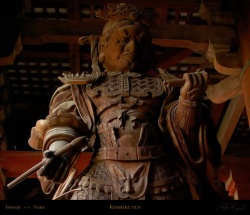Local Deities
Sheshen 社神 Local Deities Local deities (tudishen 土地神, sheshen 社神, shegong 社公, diyushen 地域神) are objects of veneration in popular Religion. The origin of local deities reaches back into prehistoric times. The earliest known local deity is Gou Long 句龍, a son of Gong Gong 共工, who according to legend tamed the floods of the rivers during the reign of the mythical emperor [[Zhuan Xu] 顓頊. It is said that Zhuan Xu appointed Gou Long as the God of the soil (sheshen), while Zhu 柱, the son of Lieshan 烈山, was made God of millet (jishen 稷神). During the early Shang period 商 (17th-11th cent. BCE), Qi 棄, the ancestor of the house of Zhou 周, was venerated as the God of Millet (Hou Ji 后稷).
The kings of the Zhou dynasty 周 (11th cent.-221 BCE) initiated three different types of patron deities, namely that of the Grand Altar (taishe 太社) that was erected west of the granary gate, those of the Royal Altar (wangshen 王社) which was to be found in the royal field compound, and the Minor Altar (haoshe 毫社) whose deities protected the souls of the former dynasties outside the main temple gate. The rites of the Zhou allowed the feudal lords to erect two altars, other Noble families only one. The two altars of the feudal lords were the soil Altar (shetan 社壇) in the east and the grain Altar (jitan 稷壇) in the west.
While Heaven was venerated as the "male" protective deity of the Earth and of the dynasty, the Earth was generally also venerated as the source of Food and prosperity. In the person of a deity, the Earth was called Hou Tu 后土 "Lord/Goddess of the Earth".
The Han dynasty 漢 (206 BCE-220 CE) ordered that in each district (xian 縣) an official Altar of the local deity (gongshe 公社) might be erected. Offerings were brought to the deities two times a year, once in the third month, and one in the twelfth month. The apocryphal texts Xiaojing yuanshen qi 孝經援神契 and Yue jiyao jia 樂稽耀嘉 from the Han period says that she 社 was the designation of a local deity protecting the community of five households, to which this community had to present sacrifices. Yet the treatise on the Five Processes (Wuxing zhi 五行志) in the history Hanshu 漢書 explains that one community included 25 households, and the chapter Jifa 祭法 in the Classic Liji 禮記 even speaks of one hundred households that belonged to one "soil community". These were not only religious, but also administrative units. The soil deity was called shegong 社公 "community leader", or simply tudi 土地 "Earth".
The Tang dynasty 唐 (618-907) called the two altars in the capital "imperial Altar of the soil" (dishe 帝社) and "imperial Altar of grain" (diji 帝稷). The Ming dynasty 明 (1368-1644) was the first to replace these ancient institutions by an ancestral Altar. Another, widely venerated local deity was the God of the Yellow River (He Bo 河伯). With the advent of Buddhism and the concurrent creation of the Daoist pantheon, such generally venerated deities lost their importance. Most local deities were only venerated in a particular area, like the Goddess of the River Xiang (Xiang Jun 湘君). The most famous, today still worshipped local deity is the goddess Mazu 媽祖 (Tian Hou 天后) that is venerated by the fishermen of the southeast coast. The Chinese always showed the tendency to name their deities, and to identify them with historical or semi-historical persons.
The Daoist text Daoyao lingzhi shengui pinjing 道要靈祇神鬼品經 from the Southern Dynasties period 南朝 (420~589) explains that the local deity of the capital was called Huang Chong 黄崇. He was a "correct minister" (zhengchen 正臣) of Heaven, and assisted Yin and Yang 陰陽 in the protection of the city. It is also said that Huang Chong hailed from Liyang 歷陽 near Jiujiang 九江, and now acted as the highest leader of all local deities in the empire. The local deity of the capital Henan 河南 was the "threefold aura" (sanguang 三光) of the Heavenly Emperor and assisted the deities of the green and the white process (east and west). His name was Dai Gao 戴高, and he came from Bohai 渤海. These informations were derived from a text called Laozi tiandi guishen mulu 老子天地鬼神目錄, a kind of list of deities. The "Classic of the Three Emperors" Sanhuangjing 三皇經 informed the reader that the protective soil deity of the province of Yuzhou 豫州 (modern Anhui north, Henan south) was called Fan Li 范禮, that of Yongzhou 雍州 (Shaanxi) Xiu Li 修理, that of Liangzhou 梁州 (Chongqing) Huang Zong 黄宗, that of Jingzhou 荆州 (Hubei) Zhang Yu 張豫, that of Yangzhou 揚州 (Jiangsu south) Zou Hun 鄒混, that of Xuzhou 徐州 (Jiangsu north) Han Ji 韓季, that of Qingzhou 青州 (Shandong) Yin Yu 殷育, that of Yanzhou 衮州 (Hebei south) Fei Ming 費明, that of Jizhou 冀州 (Shanxi) Feng Qian 馮遷迁, and that of the capital Altar Dai Gao.
Besides these "official" local deities, there were a lot of personalities exclusively venerated in particular areas. The book Soushenji 搜神記 renders the story of a certain Jiang Ziwen 蔣子文, a local military commander who had been killed by bandits. When Sun Quan 孫權 founded his empire of Wu 吳 (222-280) , the Ghost Jiang Ziwen appeared and threatened to bring disaster over the region if he was not venerated as a protective deity in this region. [[Sun} Quan]] thereupon bestowed him posthumously the title of a marquis and erected an Altar for him. The Song period 宋 (960-1279) collection Yijianzhi 夷堅志 reports the story of the writer Shen Yue 沈約 who had once presented land to a Monastery where Shen's father was buried. In order to provice a recompensation for this offer, the Monastery decided to erect a shrine for him as a local deity. In the same book the deification of Li Yunsheng 李允升 as protective deity of Dongqiao 東橋, and of Chen Yanzhong 陳彦忠 as local deity of Jianjiguan 簡寂觀 is mentioned. Similarly, Wang Zhongyin 王仲寅 became the local deity of Zhenzhou 辰州, Yang Wenchang 楊文昌 that of Huameishan 畫眉山, Huang Nianqi's 黄廿七 father that of Hukou 湖口. Similar stories are to be found in the chapter Shenyidian 神異典 in the encyclopedia Gujin tushu jicheng 古今圖書集成. Even some institutions had their own local deities. The Qing period 清 (1644-1911) book Gaiyu congkao 陔餘叢考, for example, says that the members of the Hanlin Academy 翰林院 venerated the Tang period writer Han Yu 韓愈 (Han Changli 韓昌黎) as their protector. During the Song period the National University (taixue 太學) in Lin'an 臨安 (Hangzhou 杭州, Zhejiang) brought sacrifices to the hero Yue Fei 岳飛 as a local deity. Yu Yue's 俞樾 book Chaxiangshi congchao 茶香室叢鈔 also includes a lot of interesting stories about local deities, often quoting from older sources. Yao Fujun 姚福均 says in his book Zhuding yinwen 鑄鼎餘聞 that it was custom in many districts that the local government brought sacrifices to Xiao He 蕭何 and Cao Shen 曹參, the two first Counselors-in-chief of the Han dynasty, and that Han Yu was venerated by academicians, and in the Ministry of Rites (libu 吏部).
In Yixian 黟縣 the local government venerated Xue Ji 薛稷 from the Tang, and Xianyu Xian 鮮于侁 from the Song period, while in the district of Changshu 常熟 the local academy venerated Zhang Xu 張旭 from the Tang period. It is believed that in each place deities or spirits (ling靈) are living, especially in unique natural spots like mountains and forests, rivers and swamps, hills and mounds, as well as plains and lowlands. The Fate of a peasant community was often dependant on the permanent fertility of the soil, the existence of wells and the manageable conditions of fords and mountain passes. Sudden changes in the quality of soil, or when wells and sources fell dry, storms and heavy rain inhibited travellers, or when a river burst its banks and inundated villages and fields, were ascribes to an expression of the will of the local deity. Humans were Thought to be able to offend natural spirits, which then reacted to penalize the evildoers. In the opposite case, natural deities could also reward a community that acted in accordance with the natural "wishes" of the local deity. Direct communication with local deities was also possible in the Form of incantations or prayers and offerings.
It became custom to celebrate the "birthday" of local deities on the second day of the second lunar month as "day of the local gods" (sheri 社日). The high importance of local deities for a village community is reflected in the use of the word she 社 "Altar of a local deity" for the community itself, as can be seen in the modern word shehui 社會 "society", literally "union of communities". An "Altar community" was also transformed into an administrative unit, with 25 families counting as one community during the Zhou period, and 100 families during the Ming. Each community owned one shrine or Altar (tudici 土地祠) in which the spirits of the local deities were venerated and appeased.
Local deities are often venerated as a couple, the male deity, presented as an old man, as tudi gonggong 土地公公 "grandfather of the soil", and the female deity as tudi popo 土地婆婆 "grandmother of the soil". Their direct relation to the fertility of the soil can be seen in the designations tiangong 田公 "father of the fields" and tianpo 田婆 "mother of the fields". When exactly the custom to venerate couples appeared, is unknown, but the book Yijianzhi from the Southern Song period already says that the figure of the female local deity in the shrine of Lin'an was very beautiful. During the Ming period the prefect of Taizhou 臺州 had produced a female figure for the shrine of the local deity. When Gu Gonglin 顧公璘, assistant prefect (zhongcheng 中丞 XXX) of Dongqiao 東橋, protested that there was no female local deity, an oracle was made that confirmed the existance of a female deity. The same couple of deities even produced a son, according to legend, for which a statue was erected in the local shrine.
The local deities (sheshen, tudi) must not be confused with the city gods (chenghuang 城隍). The local deities are much more popular and Thought to be closer to the normal population, while the city gods had a more official function as Protectors against enemies and pestilence, but also charged with the task to observe the behaviour of the local population.
Sources: Jiang Zihua 蔣梓驊, Fan Maozhen 范茂震, Yang Deling 楊德玲 (ed. 1992). Guishenxue cidian 鬼神學詞典, p. 6. Xi'an: Shaanxi renmin chubanshe. Li Jinde 李勤德 (1998). "Sheshen 社神", in: Tang Jiahong 唐嘉弘 (ed.), Zhongguo gudai dianzhang zhidu da cidian 中國古代典章制度大辭典, p. 685. Zhengzhou: Zhongzhou guji chubanshe. Qing Xitai 卿希泰 (1994). Zhongguo daojiao 中國道教, vol. 3, pp. NNN. Shanghai: Zhishi chubanshe. Shi Xuanyuan 施宣圓 et al. (ed. 1987). Zhongguo wenhua cidian 中國文化辭典, p. 1058. Shanghai: Shanghai shehui kexue yuan chubanshe. Zhang Yu 張玉 (2002). "Tudishen 土地神", in: Zhongguo yuanshi zongjiao baike quanshu bianji weiyuanhui 《中國原始宗教百科全書》編纂委員會(ed.), Zhongguo yuanshi zongjiao baike quanshu 中國原始宗教百科全書, p. 697. Chengdu: Sichuan cishu chubanshe.



